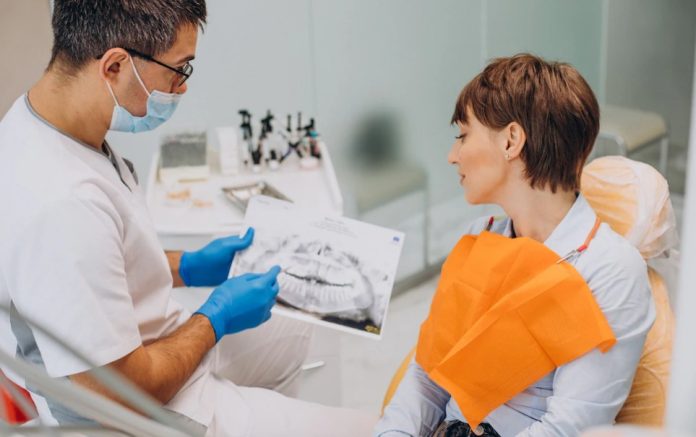Dental implants are a tooth restorative option that offers exceptional longevity, making them the most effective solution for replacing missing teeth. However, the benefits of stability and comfort come with a trade-off: a relatively extended recovery time. The recovery time is particularly long if a bone graft is necessary before the implant procedure. Despite this, the implant healing process, consisting of a two-phase recovery, proves worthwhile as it provides many years of enjoyment. Statistics show that there is a nearly 95% success rate using nobel implants, find out all you need to know about noble dental implants on this link https://dentakay.com/nobel-implants/
A dental implant comprises three components: a titanium post, an abutment, and a restoration, typically in the form of a crown. The process begins by placing the post, which must fuse with the jawbone, before adding the abutment and crown. Implants require a sturdy jawbone to anchor them securely. This means patients with insufficient bone may require a bone graft before proceeding with the implant, leading to a three-phase recovery. However, for the typical two-phase recovery, let’s focus on the following:
- After the implant post is inserted, a recovery and healing period of 3 to 6 months follows.
- Subsequently, after placing the abutment, a recovery period of 1 to 2 weeks ensues.
Once the crown is in place, the process is essentially complete, requiring no significant additional recovery. Consequently, the entire implant process typically spans from four to seven months.
Phase 1: Recovery Following Placement of the Implant Post
The implant post procedure is relatively short. For most patients, local anaesthesia is the preferred option, although heavier sedation may be used to alleviate anxiety. If local anaesthesia is used, you should be able to drive home safely afterward. However, with heavier sedation, it is advisable to arrange for a ride home.
During the first 24 hours, you may experience mild pain and tingling sensations, along with possible soreness, bruising, swelling, and minor bleeding. While dizziness, nausea, and blurred vision can occur, they are not common. It’s essential to monitor your symptoms, and if they worsen, contact your dentist promptly.
Pain Management
For managing acute pain, it is advisable to use over-the-counter medications like ibuprofen (Advil) or acetaminophen (Tylenol) every six to eight hours. Taking these medications before the anaesthesia wears off can help ease the transition into the recovery period. If the pain persists, you may use prescription medication if approved by your dentist. However, after a few days, you should no longer need it.
Resuming Regular Activities
Initially, it is recommended to take it easy. Some patients may return to work, while those with more demanding jobs might need to take one or two days off. Strenuous activities such as workouts and sports should be avoided for at least three full days or until you no longer need pain medication.
Eating & Drinking
During the recovery period, stick to soft foods like smoothies, shakes, thick soups, yoghourt, and pureed foods. Avoid using a straw, as the suction can dislodge the clots at the incision site. Additionally, hot and spicy foods should be avoided, as they can irritate the surgical area. While recovering, your body will guide you, and you can gradually reintroduce regular foods based on your comfort level. It is normal for this process to take several weeks.
Smoking & Drinking Alcohol
Both smoking and alcohol consumption can hinder the healing process and increase the risk of infection. It is crucial to avoid nicotine and alcohol for at least one week after the surgery, and ideally for a longer period. While a nicotine patch is acceptable, nicotine gum and chewing tobacco should be avoided as they have similar adverse effects as smoking during this time.
The Waiting Period
After your initial surgery and recovery phase, you must allow your jawbone sufficient time for osseointegration to occur. The duration of osseointegration can vary, typically taking anywhere from three to six months. It depends on factors such as the quantity and quality of your bone, your individual risk factors as a patient, and the expertise of your surgeon. Your dentist will regularly monitor your progress during check-ups. The sooner the dentist determines that the implant is fully ready, the quicker you can progress to the next stage of treatment.
Phase 2: Recovery Following Abutment and Crown Placement
To place the abutment, the dentist will need to make an incision in the gum to access the post. Local anaesthesia will be administered to minimise discomfort, resulting in similar side effects as mentioned before. This process may cause some pain and soreness, which typically subsides within one to two weeks.
During this period, it is advisable to return to consuming soft foods for a few days before gradually reintroducing your regular diet. After a couple of weeks, you will revisit the dentist to have the permanent crown placed. Since this step involves no incisions, apart from the possibility of having tender gums, you won’t face any eating or oral care restrictions.
Factors Affecting Recovery Time:
- The number of implants: While some implants may require slightly longer healing periods than others, the difference is negligible enough that many patients choose to have all their implants done simultaneously. This way, they can manage the recovery of multiple teeth at once, streamlining the process.
- The location of the implants: The healing time can vary based on the location of the implants. Generally, implants in the lower jawbone tend to heal more quickly compared to those in the upper arch.
- Bone grafting: If you underwent bone grafting, it can significantly impact your total recovery time. The graft site must be fully healed before proceeding with post placement, and this healing process can take anywhere from three to nine months.
Long-Term Care Tips
Dental implants are durable and can last a lifetime with proper care. Treat them with the same level of care as your natural teeth, and they will serve you well over the years.
Follow recommended oral health practices, including brushing your teeth twice daily, flossing at least once a day, and regularly visiting your dentist. By adhering to these routines, you can minimise wear and tear on the implant(s) and maintain the health of the surrounding gums.
To begin the dental implant process, schedule a consultation with us today! During this consultation, your oral health will be assessed, and suitable treatment options will be discussed. If you don’t have a dentist yet, you can check out this one who does crowns and the best dental implants in Lexington MA.
Disclaimer: This article contains sponsored marketing content. It is intended for promotional purposes and should not be considered as an endorsement or recommendation by our website. Readers are encouraged to conduct their own research and exercise their own judgment before making any decisions based on the information provided in this article.






























































